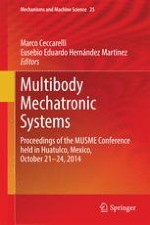
2015 | OriginalPaper | Buchkapitel
Kinematic and Workspace-Based Synthesis of a 2-DOF Mechanism for Haptic Applications
verfasst von : R. Roberts, E. Rodriguez-Leal
Erschienen in: Multibody Mechatronic Systems
Aktivieren Sie unsere intelligente Suche, um passende Fachinhalte oder Patente zu finden.
Wählen Sie Textabschnitte aus um mit Künstlicher Intelligenz passenden Patente zu finden. powered by
Markieren Sie Textabschnitte, um KI-gestützt weitere passende Inhalte zu finden. powered by